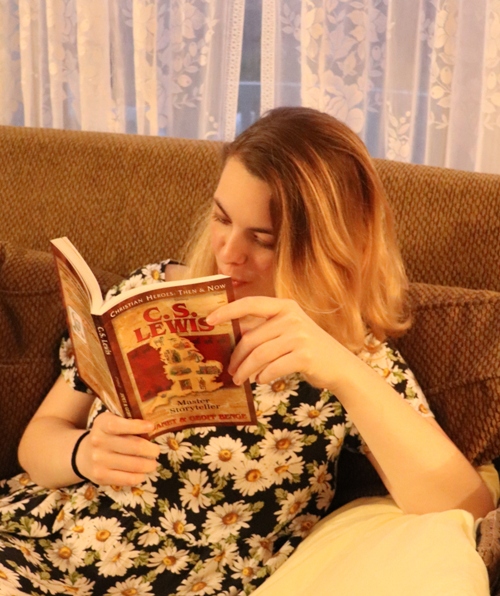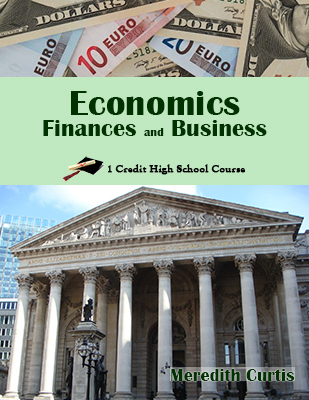Homeschooling parents who start their homeschooling journey with the delight of discovery through living books and real-life learning will be happy to know that you can still homeschool with living books in high school.
From the beginning, I have centered my homeschool around living books. We read well-written, beautifully illustrated picture books when the children were little. As they grew older, we found the original Winnie-the-Pooh books in used bookstores, as well as Thorton Burgess books and Beatrix Potter books. We devoured those and other living books.
Our unit studies focused on living books too. A study on London might center around reading Mary Poppins aloud chapter by chapter each day. We used biographies and historical fiction to make history come alive.
For more on homeschooling with living books, read my blog post 5Ways to Homeschool with Living Books.
There is a plethora of living books for elementary and middle school, but what about high school? Don't you have to pull out the textbooks for high school? Well, you can do that, but there are living books for high school too.
Living Books In High School
When Katie Beth hit eighth grade, I designed her high school courses. I centered them around living books. For Bible classes, she read the Scriptures (THE LIVING BOOK of all living books) along with a few fiction and non-fiction books to make them come alive. For character/life skills classes, we read inspirational books and Bible studies.
But what would I do about economics, history, and science?
Would it be possible?
We used living books for Human Anatomy class and delved into Economics with a bunch of great books on economics that were a lot more interesting than a dull, dreary textbook.
For history, we found some audios, living textbooks, biographies, historical fiction, and other exciting books! We read original documents and books written in the time we were studying:
- Constitution
- Log of Christopher Columbus
- Adventures of Marco Polo
- Plutarch’s Lives
- Plimoth Plantation
- Diary of David Brainerd.
High School Courses with Living Books
What I did was to choose books that taught the subject well, covering the topics I wanted to cover in an interesting, easy-to-remember or insightful way. I looked to the classics as well as modern books. Then I created courses around those books.

Let me give you an example with my economics course.
Living Books Course Example: Economics
I wanted to teach economics without fear. Most people hear the word economics and get frightened away, too scared to ever really understand it.
I decided to have my teens read two classics: Wealth of the Nations by Adam Smith and The Communist Manifesto by Karl Marx. These two works have greatly influenced how we look at the economy in America. Wealth of the Nations was published the same year our Founding Fathers signed the Declaration of Independence. Yet in the 21st Century, many Americans want to put into practice the teachings of Karl Marx. I wanted my children to read this communist classic themselves and understand his ultimate goals so they are not deceived by smooth talk.
I also found an easy-to-understand series, the Uncle Eric books from Bluestocking Press. Whatever Happened to Penny Candy? by Richard Maybury helped me and then my teens understand inflation clearly. No more confusion! We read several of his books that year. We also discovered a free-market classic, Economics in One Lesson: The Shortest and Surest Way to Understand Basic Economics by Henry Hazlitt. This book is amazing! In fact, my engineer son just thanked me in our Christmas chatting last month for having him read that book!
I didn’t want to stop there! I also wanted to teach my teens to manage money for their future households one day and to plan and start a business. I dug out some books that had really helped my husband and I in the early years of our marriage learn to budget, save, and manage money effectively. There was even Business by the Book by Larry Burkett to start us off on our own entrepreneurial adventure.
We added all kinds of practical assignments that were easy and fun like the Apartment Project and making a logo for your business. Read more about this in my blog post OurMost Popular Economics Assignment: The Apartment Project.
Beyond my own children, I have taught my economics courses to many teens, as well as those who have purchased my book to use in their home school. Hands-down it is my most popular course!
What? With all that reading.
Well, all the reading is practical and applicable to real life. Students come back to me years later thanking me for teaching them economics. Of course, I can’t take the credit. It was Adam Smith, Larry Burkett, and Richard Maybury who really taught them.
Life Prep Courses
In my own life, women like Elisabeth Eliot, Edith Schaeffer, and Emilie Barnes have befriended me through their books. They taught me to put God first and to love the people in my life in practical ways that make them feel valuable.
Classic authors like Andrew Murray, St. Augustine, C.S. Lewis, Derek Prince, and John Piper have left their mark on my heart. Reading inspirational books doesn’t replace Bible study, but it brings encouragement and delight.
My teens would not stay teens forever. They would grow up, enjoy careers, get married, have children, and maybe homeschool. I wanted to prepare them for the future with some life skills courses that, of course, were focused on living books.
In my daughters’ Homemaking course, we used The Hidden Art of Homemaking by Edith Schaeffer enjoying it chapter by chapter while we had a blast with cooking, sewing, needlecraft, cake decorating, and more!
In my son’s Leadership course, he read many books including some very practical ones by John Maxwell. These books, along with opportunities to put what he was reading into practice, impacted his life!
Literature Courses
For literature, we read entire books and talked about them, instead of reading excerpts. I focused on letting my children enjoy timeless classics rather than analyzing them to death.
For some literature courses, I’ve given my children a list of authors and asked them to read at least one book from each author and as many books as they’d like from authors they enjoy.
One of my daughters became quite the Jane Austen fan and another really enjoyed C.S. Lewis as a result of their British Literature course. They still read these authors today as grown women who live busy lives.

A Writing Classic
Early on in my homeschool journey, I heard an older mom recommend a tiny book by the author of Stuart Little. Elements of Style by E.B. White is packed with great writing advice. Each year I had my teens read this book at the beginning of the school year and I have to pass this gem on to you!
For more about what I cover in English courses, read my blog post WhatStudents Learn in My 1-Credit High School English Courses.
Where to Go From Here
Okay, I have bombarded you with books! Where do you go from here?
If your teens are avid readers, just put good books in their hands. You are ready to go!
If they are not avid readers, then wean them away from TV and video games with reading classic literature aloud. Start with easy-to-understand classics written for children like Swiss Family Robinson, Little Women, and Robin Hood. Assign them childhood classic they haven’t read yet and some biographies that will engage them. The Landmark series is a great introduction to living books that teach history.
Start slowly. You might just add historical fiction to history class. Or a novel set in a foreign country for geography.
No one is ever too old to discover the magical enchantment of living books. Even teens!
God bless you on your wonderful adventure of homeschooling high school!
Until next time, Happy Homeschooling!
Warmly,
Meredith Curtis
 FREEBIE!! Be sure to grab my Freebie, Reading List Collection for Teens!
FREEBIE!! Be sure to grab my Freebie, Reading List Collection for Teens!
Enter to win all the giveaways on the Homeschooling Upper Grades landing page!
You may also like...


***************



























